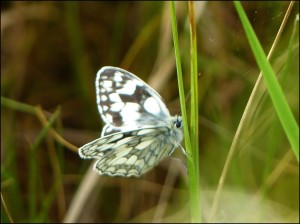24th June was a great day for local butterfly enthusiasts as Mike Robinson came across a Marbled White (Melanargia galathea) at Hollyhill Open Space off Brook Street in Erith, only days after we had discussed keeping an eye open for it in the Borough, and also managed to get a photograph. This would appear to be a wholly new record (or at least new ‘modern’ record) for the species in our area. Meanwhile, the birding duo of Ralph Todd and Ian Stewart, out biking around Joydens Wood on the same day, spotted a White Admiral (Limenitis camilla) on the woodland edge of a ride bordering Chalk Wood, which confirms a previously ‘unverified’ sighting from over a decade ago.
The London Biodiversity records centre (GiGL) has no records of Marbled White in Bexley, though there are a couple of recent records from Bromley on the internet, and it appears to be spreading eastwards in the country as a whole, having been more numerous in the west. GiGL holds a single ‘unverified’ record from 2003 of White Admiral from Gatton’s Plantation, which is near Chalk Wood.
Mike, a recent convert to the joys of watching and photographing butterflies said “After spending most of the day in the Canary Wharf area I decided to pop down to theHolly Hill Open Space for an hour or so. I had vague hopes of a Ringlet (or two!) but no such luck; although Large and small Skipper species, Small Tortoiseshells and Meadow Browns were about. But I also spotted this character whooshing and swooshing about. She/he led me a merry dance trying to get a picture. In the end I managed one; not the best one you will ever see but it’s her/him.”

This Marbled White, found by Mike Robinson at Hollyhill open space in Erith is a first (at least in modern times) for Bexley. (Photo: Mike Robinson)
So far we have not found any historic data on the internet to suggest that the species has ever been present in Bexley. There is no printed butterfly atlas for Kent or London where the authors would have gone through old literature and possibly museum specimens. The latest GiGL dataset, which came through last week, has no Bexley Marbled White records, with the nearest being a 2002 sighting at Barking Reach on the other side of the water. Kent and Medway Biological Records Centre may have old VC16/West Kent records of butterflies from over their border into that part of London that was once in Kent, but we haven’t checked yet.
Meanwhile, the latest London Natural History Society records review (up to the end of 2014) says that Marbled White is still pretty much restricted to the west/north west fringes of the capital.
The other issue would be whether someone has ‘bred’ Marbled Whites (which usually means they’ve raised caterpillars rather than actually kept breeding adults and raised them from eggs) and released them in the area. There have been a number of species around the country where concerns have been raised that ‘unusual’ records could be down to this, but Marbled White has not been one of them. A basic internet search has not turned up any commercial outfits offering Marbled White caterpillars or pupae. It seems likely that it is a ‘legitimate’ record for the species, certainly the first ‘modern’ one, and that Mike was lucky to be in the right place at the right time, which basically boils down to putting in the miles and hours – and even now anyone that does so still has a good chance of turning up something unusual now and again without having to be a complete expert.
Given how rapidly Ringlet appears to have spread in Bexley in the last couple of years, maybe Marbled White can do the same if there is more than one in the vicinity, or this individual is an already fertilised female with eggs.
Turning to the White Admiral, the species increased dramatically in the 1920s, but has declined significantly in the UK in the last 20 years for unknown reasons. The person who saw it locally in 2003 was top botanist Mark Spencer. If he had a decent view, his judgement was probably correct, as it’s distinctive enough not to be easily muddled with anything else. Ralph and Ian’s sighting would strongly suggest that he did see one. Their own record was somewhere close to the border with Kent, and although they’re not sure which side, point out that the insect probably wanders. In any case, Gatton’s plantation is wholly on our side of the county line, so it looks pretty likely the species is established in the Borough of Bexley after all. The larvae of this woodland species feed on native Honeysuckle. Some targeted recording effort is now in order to go and find out what sort of population and distribution there is down there.
Ian Stewart is also reporting Small Heath (an uncommon species in London) on Upper College Farm. He says it’s been there at least 3 years. He also said Ringlet is on the wing there, another new site for this fast-spreading species, and he had Painted Lady at Crayford Ness the other day as well.
These records have the added benefit of putting the high value of some of our less well studied open spaces in the spotlight, so other readers are strongly encouraged to get out and see what they can find! Meanwhile that Bexley butterfly checklist needs revising and we are going to be saying that Bexley now provides a home to 28 species of butterfly (up 2) , which is almost half of the 59 regular breeding species (excluding vagrants and accidental introductions) found in the UK as a whole…….
Chris Rose
